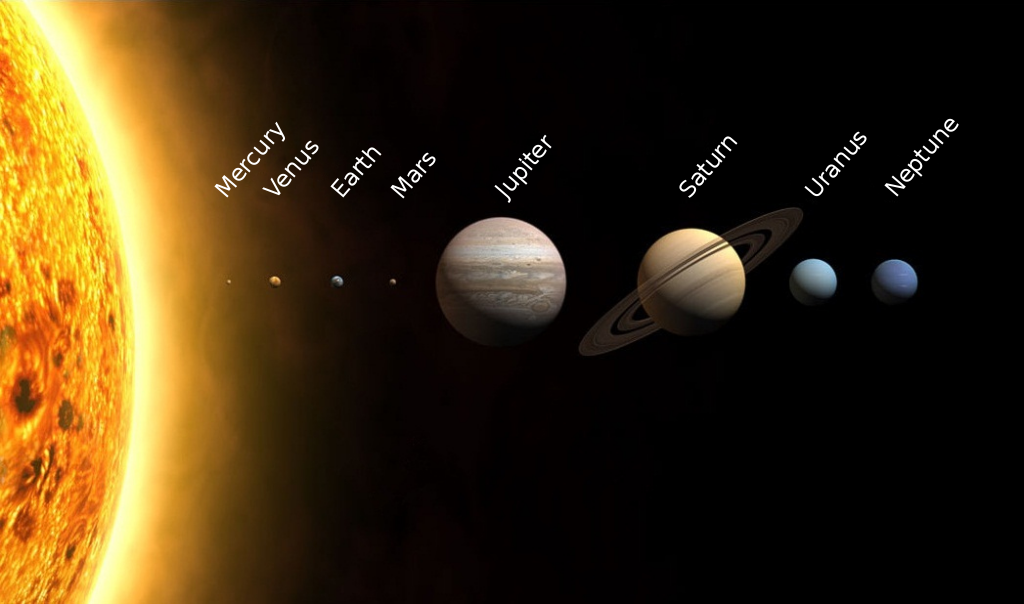The Solar System is the gravitationally bound system of the Sun and the objects that orbit it, either directly or indirectly. Of the objects that orbit the Sun directly, the largest are the eight planets, with the remainder being smaller objects, the dwarf planets and small Solar System bodies. The 8 planets in our solar system are:

Mercury is the closest planet to the Sun, and the first of the inner planets. The smallest planet in the Solar System, Mercury has no natural satellites. Besides impact craters, its only known geological features are lobed ridges or rupes that were probably produced by a period of contraction early in its history. Mercury's very tenuous atmosphere consists of atoms blasted off its surface by the solar wind.
Venus is close in size to Earth and, like Earth, has a thick silicate mantle around an iron core, a substantial atmosphere, and evidence of internal geological activity. It is much drier than Earth, and its atmosphere is ninety times as dense. Venus has no natural satellites. It is the hottest planet, with surface temperatures over 400 °C (752 °F), most likely due to the amount of greenhouse gases in the atmosphere. No definitive evidence of current geological activity has been detected on Venus, but it has no magnetic field that would prevent depletion of its substantial atmosphere, which suggests that its atmosphere is being replenished by volcanic eruptions.
Earth is the only place where life is known to exist, and it is our home planet.Earth (1 AU from the Sun) is the largest and densest of the inner planets, the only one known to have current geological activity, and the only place where life is known to exist.
Mars, also known as the "Red Planet", is smaller than Earth and Venus. It has an atmosphere of mostly carbon dioxide with a surface pressure of 6.1 millibars (roughly 0.6% of that of Earth). Its surface, peppered with vast volcanoes, such as Olympus Mons, and rift valleys, such as Valles Marineris, shows geological activity that may have persisted until as recently as 2 million years ago. Its red colour comes from iron oxide (rust) in its soil. Mars has two tiny natural satellites (Deimos and Phobos) thought to be either captured asteroids, or ejected debris from a massive impact early in Mars's history.
Jupiter is the largest planet in the solar system. It is a gas giant. It is 2.5 times the mass of all the other planets put together. Composed largely of hydrogen and helium, Jupiter's strong internal heat creates semi-permanent features in its atmosphere, such as cloud bands and the Great Red Spot. Jupiter has 79 known satellites. The four largest, Ganymede, Callisto, Io, and Europa, show similarities to the terrestrial planets, such as volcanism and internal heating.
Saturn, the other gas giant, is distinguished by its extensive ring system. It has several similarities to Jupiter, such as its atmospheric composition and magnetosphere. Although Saturn has 60% of Jupiter's volume, it is less than a third as massive. Saturn is the only planet of the Solar System that is less dense than water. The rings of Saturn are made up of small ice and rock particles. Saturn has 82 confirmed satellites composed largely of ice. One of them, Titan, is the second-largest moon in the Solar System.
Uranus, the first of the ice giants, is the seventh planet from the Sun. Like the other giant planets, Uranus has a ring system, a magnetosphere, and numerous moons. The Uranian system has a unique configuration because its axis of rotation is tilted sideways, nearly into the plane of its solar orbit. Its north and south poles, therefore, lie where most other planets have their equators. Observations from Earth have shown seasonal change and increased weather activity as Uranus approached its equinox in 2007. Wind speeds can reach 250 metres per second (900 km/h; 560 mph).
Neptune, the other ice giant, is the eighth and last planet in the solar system. It is the fourth-largest planet by diameter. It is 17 times the mass of Earth and slightly more massive than its near-twin Uranus.